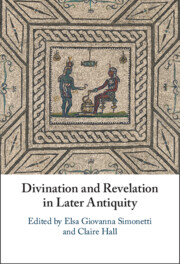Book contents
- Divination and Revelation in Later Antiquity
- Divination and Revelation in Later Antiquity
- Copyright page
- Contents
- Illustrations
- Notes on Contributors
- Acknowledgements
- Introduction
- Part I Philosophical Perspectives on Divination, Revelation, and Prophecy
- Chapter 1 Theories of Prophecy in Philo of Alexandria
- Chapter 2 The Neoplatonic Background of a Text on Prophecy Attributed to John Chrysostom
- Chapter 3 ‘Revelation’ for Christians and Pagans and Its Philosophical Allegoresis
- Chapter 4 Divination and Dialogue in Porphyry and Iamblichus
- Part II Status, Role, and Functions of Human Intermediaries
- Part III Divine Transcendence and Pragmatic Purposes
- Index
- References
Chapter 4 - Divination and Dialogue in Porphyry and Iamblichus
from Part I - Philosophical Perspectives on Divination, Revelation, and Prophecy
Published online by Cambridge University Press: 19 October 2023
- Divination and Revelation in Later Antiquity
- Divination and Revelation in Later Antiquity
- Copyright page
- Contents
- Illustrations
- Notes on Contributors
- Acknowledgements
- Introduction
- Part I Philosophical Perspectives on Divination, Revelation, and Prophecy
- Chapter 1 Theories of Prophecy in Philo of Alexandria
- Chapter 2 The Neoplatonic Background of a Text on Prophecy Attributed to John Chrysostom
- Chapter 3 ‘Revelation’ for Christians and Pagans and Its Philosophical Allegoresis
- Chapter 4 Divination and Dialogue in Porphyry and Iamblichus
- Part II Status, Role, and Functions of Human Intermediaries
- Part III Divine Transcendence and Pragmatic Purposes
- Index
- References
Summary
Divination was an important focus of philosophical dialogue and ‘pagan’-Christian religious debates in late antiquity.One of the most extensive late antique exchanges on the nature of divination and other religious practices is that evident in Porphyry’s Letter to Anebo and Iamblichus’ Reply of the Master Abamon to the Letter of Porphyry to Anebo and the Solutions to the Questions It Contains. This chapter re-assesses the key features of this exchange, arguing for its status as an important philosophical dialogue which bears some resemblance to oracular modes of discourse. In order to support this argument, the broader status of questioning, interrogation, and inquiry in traditional Greek oracular practices and within Platonism is examined. The chapter analyses the ways in which Porphyry’s and Iamblichus’ exchange is framed within these philosophical and oracular contexts, demonstrating that this dialogue draws implicitly on Socrates’ interrogation of the Delphic oracle as presented in Plato’s Apology and on Plutarch’s Delphic Dialogues. The citation and discussion of Porphyry’s Letter to Anebo by the Christian Church Fathers Eusebius and Augustine will also be considered in relation to exploring pagan-Christian religious approaches and debates.
- Type
- Chapter
- Information
- Divination and Revelation in Later Antiquity , pp. 73 - 96Publisher: Cambridge University PressPrint publication year: 2023



